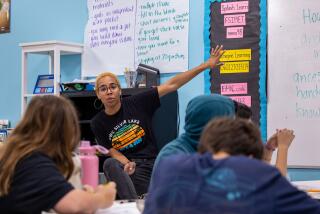Reduce High School Class Sizes, Too
- Share via
For as long as I can remember, my classes have been so big some were out of control, and the teacher didn’t have enough time to help each student individually.
That is one thing this year’s students in grades K-3 won’t have to experience.
The smaller our classes, the more children will learn. This is the assumption this year’s class-size reductions have been based on. So far the statewide movement seems to have worked, with children in the early primary grades in classes of 20 or less.
“You just can’t help but do a better job, be more effective,” said Fran Ford, a Poinsettia School teacher working with 20 Ventura third-graders this year. “I keep thinking I’m going to wake up and find 34 kids in my class.”
But when I walked into my own classes at Buena High two weeks ago, I realized these new steps toward smaller classes are not enough. The majority of my classes have 36 kids in them, about 16 too many. My Spanish class started off full and has received at least one new student each day since. There is no sense of community, almost no personal time with the teacher.
Why don’t high school students rate the same class-size reduction as grades K-3?
“We have no way to self-generate money,” Supt. Joseph Spirito said. “We stand there with our hands open and wait for the state to hand us funds. Stand there and say, ‘Please, governor, help us.’ ”
The question on many people’s minds may be, How would smaller classes affect high school students?
I talked to my principal, Jaime Castellanos.
*
“Teacher-student interactions would be the main difference. . . . If students are happier with their classes and their teachers, they tend to learn better.”
My first-period class, Honors English, has 19 students in it. From the first day there has been a sense of community and a relationship with our teacher. By the end of our first period together, I knew the name of everyone in the class. I’m not even good with names.
It is this kind of community atmosphere that has been shown in the reduced classes at the elementary level. As Mrs. Ford said, “After four days, I feel like they’re my family, not my class.”
I see the reason the early grades were reduced first. They lay the foundation for a child’s learning style and expectations of themselves as well as teaching primary tools: reading, writing and arithmetic.
Early grades build the foundation for the house that is to be a student’s education, and I realize that this foundation must be laid in stone. But what good is a stone foundation when the walls are built of straw?
Near the end of our conversation, Mrs. Ford said, “It’s like a dream come true. . . . I never thought I would live to see this. Children who are shy are not intimidated as much as they might be in the larger classes. I feel like I’m going to do so much better this year.”
Reducing class size in the first few grades of children’s schooling was a wonderful step. But that’s just what it is, a step. Many more must come before the project of raising educational standards is complete.
More to Read
Sign up for Essential California
The most important California stories and recommendations in your inbox every morning.
You may occasionally receive promotional content from the Los Angeles Times.










